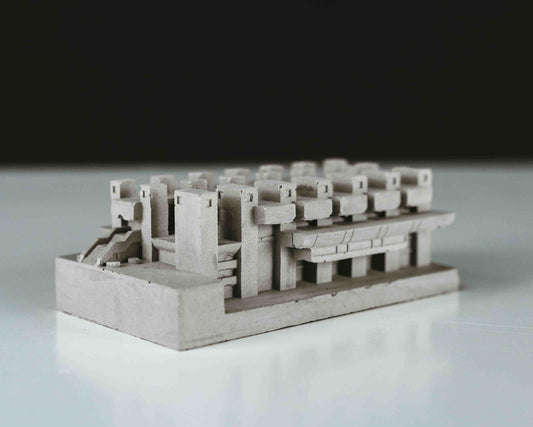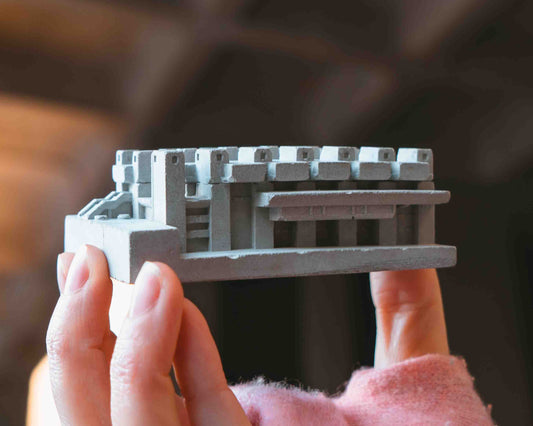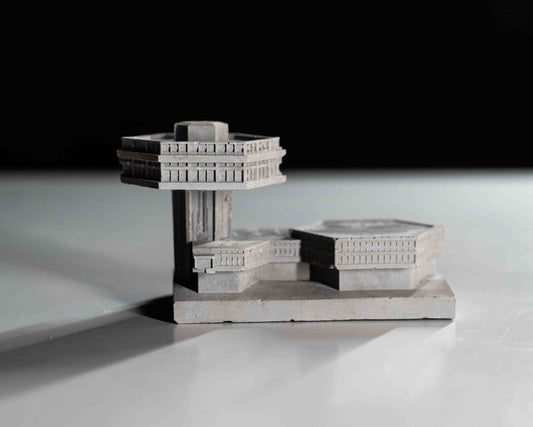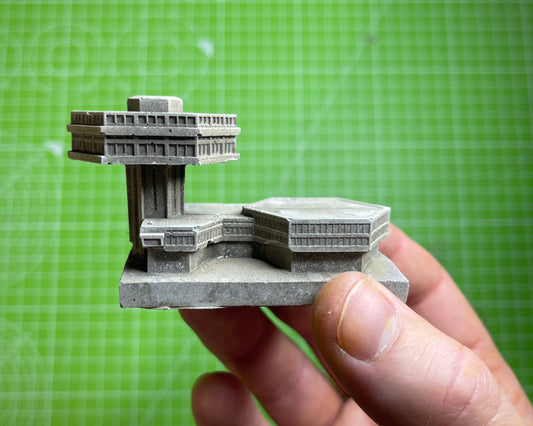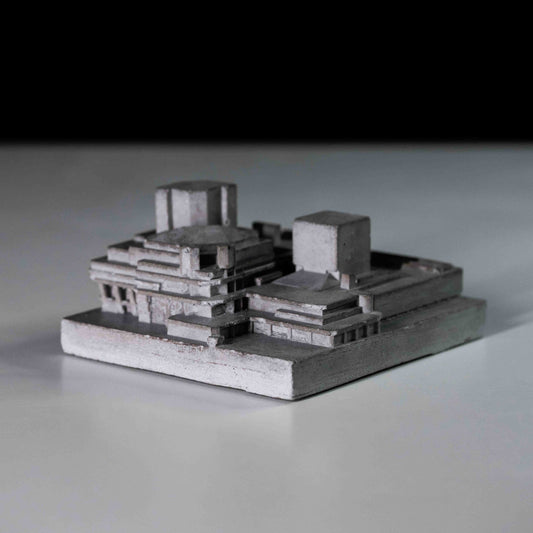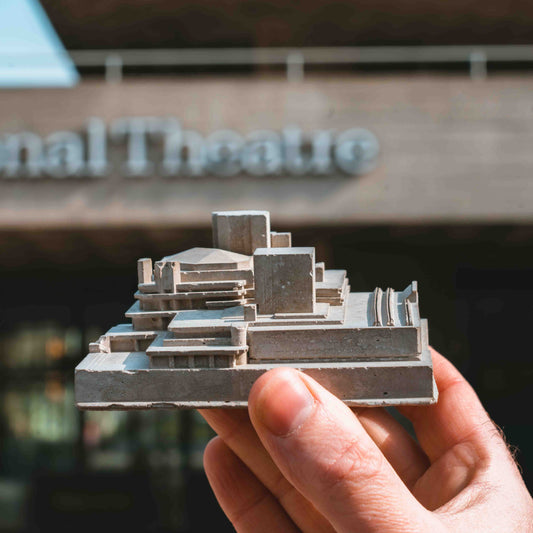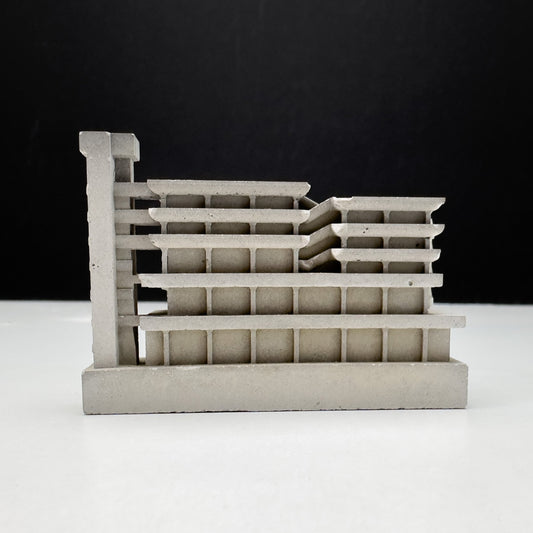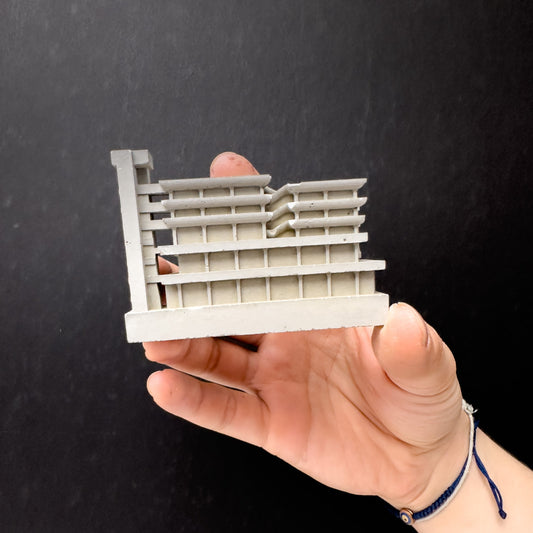Scroll to Learn About this Unique Style
An Introduction to the Story of Brutalism
Brutalist architecture is bold, raw, and unforgettable. Made with materials like concrete, steel, and brick, Brutalism emerged in the mid-20th century as a radical answer to post-war reconstruction. Its striking buildings are often large-scale housing estates, public buildings, and civic centres that speak of a time when architecture was designed to serve society.
My passion for Brutalism has led me to creating cast-concrete Brutalist miniatures as a personal and tactile way to collect the places that formed our memories.
This page offers a short introduction to the movement, its origins, and how it inspires everything I create.
"It was about making thoughtfully designed architecture
accessible to the public, rather than just for the wealthy."
What is Brutalism? (In Plain Language)
The term Brutalism comes from the French béton brut, meaning 'raw concrete'. But Brutalism isn’t only about concrete, it’s about honesty in design. You’ll recognise brutalist buildings by their exposed materials, geometric forms, heavy shadows, and dramatic scale.
Brutalism wanted architecture to be stripped of all decoration. It was functional, structural, and socially driven, a new architecture that was driven by purpose and for the people. From council estates to cultural centres, the style aimed to rethink how buildings could shape lives and hold communities. It was about making thoughtfully designed architecture accessible to the public, rather than just for the wealthy.
A short history of Brutalist architecture
Brutalism emerged in the 1950s, as architects across Europe responded to the aftermath of war. Cities needed rebuilding, and materials were limited. But ideas were strong. New housing estates, schools, libraries, and civic centres were now being designed not for prestige, but for public life.
British Architects Alison and Peter Smithson coined the term 'Brutalism' out of Le Corbusier’s use of béton brut (brut meaning raw), which described his use of rough, unfinished concrete in post-war buildings like Unité d’Habitation. It was the Smithsons who gave Brutalism a distinctly British, socially conscious and post-war identity. Inspiring others such as Ernő Goldfinger and Neave Brown to build with clarity and conviction. Concrete was used not to dominate, but to express intention. Every surface was part of the structure. Every void had a purpose.
Brutalist architecture spread across the UK and beyond, creating landmarks like:
- Trellick Tower, London
- Park Hill, Sheffield
- Cumbernauld Town Centre, Scotland
- Boston City Hall, USA
- Torres Blancas, Madrid
Each one was shaped by the political, social, and material realities of its place — and each one invites us to look more closely.
Often misunderstood as 'ugly' or oppressive, many Brutalist buildings were neglected or demolished. But today, they’re experiencing a cultural revival, appreciated for their raw beauty, integrity, and radical vision.
"Brutalism is a reminder that architecture can hold meaning.
It can reflect values. It can carry memory and shape identity."
Why Brutalism Still Matters Today
Brutalism is being looked at again, its bold silhouettes, deep shadows, and textured surfaces drawing a new wave of attention, especially through photography. But its importance runs deeper than image.
It tells the story of a belief that architecture should be for everyone. It speaks of public ambition, of a vision for shared cities. These buildings, solid, and sometimes severe, carry stories of community, ambition, and change.
They were designed with a care and conviction shaped by ideals that placed community, function, and equality at the centre.
Many find them harsh. Others find comfort in their presence, in their clarity, their durability, their refusal to back down or apologise.
To me, Brutalism is a reminder that architecture can hold meaning. It can reflect values. It can carry memory and shape identity. And now, as many Brutalist landmarks face demolition or are left to decay, we risk losing not only their impactful design, but also the social ideals they represent.
Through study, documentation, and making, I am trying to create new ways to connect with them, and to help keep their legacy alive.
Celebrating Brutalism in Miniature
Spaceplay began from my deep personal connection to Post War Urban Landscapes; the ones that shaped my childhood and creative thinking.
What started as admiration became a practice of documenting and collecting. I began casting miniature brutalist buildings in concrete to honour the forms and ideas behind them.
The process involves 3D printing, silicone mould-making, and fine concrete casting. The result is a small piece of architecture you can hold in the palm of your hand. They are small but weighty, tactile reminders of buildings that shaped our cities, and lives.
Explore some of my most loved pieces
Where to go from here
If you’ve found yourself curious about Brutalist architecture, you’re not alone. Spaceplay is for people who see value in overlooked buildings, who care about place, and want to hold onto and share their stories and memories. You can find out more about my story and work with the links below.
What Is Brutalist Architecture? A Simple Introduction to Brutalism + Concrete Models |Spaceplay
Learn what Brutalist architecture is, where it came from, and why it still matters.
Discover its history, meaning, and cultural legacy. Learn why Spaceplay creates
handmade concrete models that honour iconic Brutalist buildings.


